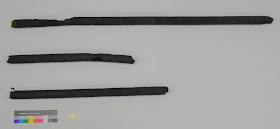 |
| Rendering shows snorkels above conning tower (Friends of the Hunley) |
A Friends of
the Hunley press release this week said Clemson University researchers
determined the doomed sub’s air circulation system was not in use when it made the historic
February 1864 attack on the USS Housatonic.
During ongoing
conservation, scientists and researchers found that a rubber hose connecting
snorkel tubes to hand-pumped bellows was “intentionally disconnected and tucked
underneath the crew bench.” The reason remains unknown.
The
snorkel-bellows system was intended to pump out carbon dioxide and allow the replenishment
of good air from the surface. The snorkel tubes were in a lowered position and
not engaged during the attack, researchers said.
 |
| Set of bellows before, after conservation (Friends of the Hunley) |
The Hunley
could hold enough oxygen for the crew to survive for roughly two hours. There
were two ways to replenish the supply.
“One was to use the air circulation system, which was
designed to be stealth and allow them to discreetly get fresh air,” the release
said. “The only other alternative was to come to the surface and open the
hatches, a potentially dangerous move if enemy ships were nearby.”
 |
| Rubber hose was part of air circulation system |
The Friends group said the Hunley crew may have opted to stay well below the surface after sinking the Housatonic so as to escape detection. "If they miscalculated the timing or thought it was too dangerous to come back up to open the hatches for air, they may have slowly run out of oxygen to breathe."
On Feb. 17, 1864, the Hunley left its base on Sullivan’s
Island, S.C., and placed its torpedo into the Housatonic, one of many blockade
vessels on the edge of the harbor. Those on board desperately opened fire on
the attackers. Five U.S. sailors were killed in the explosion and a chaotic
scene ensued as other Federal ships came to the rescue. The Hunley vanished,
and there have been many theories – but no proof -- of what happened to it.
 |
| Snorkel box before and after conservation (Friends of the Hunley) |
 |
| Conserved snorkel tubes (Friends of the Hunley) |
The organizations cautioned that it could have been a
combination of factors that caused the disappearance.
But researcher Rachel Lance told CNN in 2017 that the crew died from blast injuries.
Shock waves from the torpedo detonation would have instantly
killed those aboard the Hunley, she said. Such
strong pressure would rupture lungs and damage neurons and blood vessels, she argued.
And she discounted the theory of
suffocation.
 |
| Rachel Lance |
“The crew had about a 30-minute air supply
before they would have had painful and uncomfortable symptoms from carbon
dioxide,” Lance said. “They made no efforts to try to save themselves or bring
air into the boat.”
The U.S. Navy
and the Friends of the Hunley pushed back.
A
week after the findings of her team were released, the Friends of the
Hunley issued a press
release that said Lance’s work is “unsubstantiated.”
“While the likely cause of the submarine’s demise has not
been concluded, the scenario of a concussive wave killing the Hunley crew has
been deemed not likely by those working on the actual submarine and who have
access to this key data,” the organization said.
The Navy has questioned why
World War II submariners survived close depth charges while the Hunley crew did
not survive the torpedo blast. Lance said modern hull armor is much thicker and
would have provided more protection.
Lance told a 2017 audience that the watch of sub commander
Lt. George Dixon provides further evidence of the effects of a traumatic blast. The hands
stopped at 8:23 p.m, the estimated time the torpedo went off.
 |
| Bellows before conservation (Friends of the Hunley) |
No comments:
Post a Comment